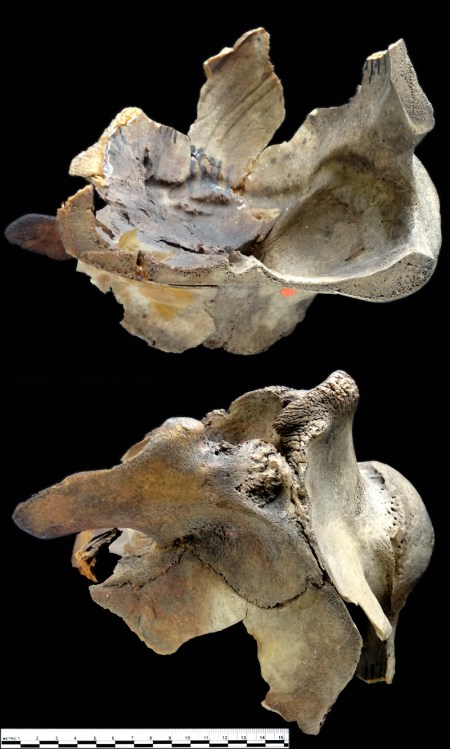On Friday I gave you this scrappy bit of bone to identify:
It came into the Horniman collections from King’s College in the 1980s and it was tentatively identified as a piece of ungulate bone. I’m pleased to say that you managed to do a better job of identifying the specimen than was done originally! In particular Jake managed to narrow it down to being part of the braincase of a cetacean, possibly a species of dolphin or porpoise, with henstridgesj and RH also thinking along the same lines.
When I first saw this piece of bone I also thought it belonged to one of the smaller toothed whales and so moved it from its place among the ungulates to a place in the collection with other cetaceans. This proved to be a fruitful move, since I was checking through the various bit of whale at work the other day and suddenly realised that there was a broken piece of whale rostrum also from the King’s College collection. When I put them together, this is what I got:
A perfect fit! This meant that the identification of toothed whale was confirmed and even better the specimen could be identified as being from a Beluga Whale Delphinapterus leucas (Pallas, 1776). It goes to show that even a general identification of a specimen is useful!
Beluga are an Arctic whale species, closely related to Narwhals. They feed on a variety of fish, molluscs and crustaceans, with a particular penchant for Pacific Salmon. The big bump on their forehead when they’re alive is where the organ called the melon is situated. This waxy bulb is very large in Beluga and it acts as a lens for focusing sound that is emitted from their phonic lips as part of their useful echolocation ability. The returning sound is received as vibrations which pass through the lower jaw and are focused into the auditory bullae where they are transmitted by the ear bones (ossicles) to the cochlea.
Being able to echolocate makes hunting for food much easier in the low light levels under sea ice. The noises produced through this process can also be used to communicate with other whales and, according to a report a couple of months ago, to mimic human sounds. Pretty impressive considering that whales produce sound in such a thoroughly different way to humans – usually at a totally different frequency.





The two pieces together are upside-down, aren’t they? (It’s taken me a while to match it with an image of a complete skull)
Yep, it is indeed upside-down, I was intending to flip the image, but I totally forgot.
No problem; my image viewer has flipperbility.
Much like a Beluga 😉